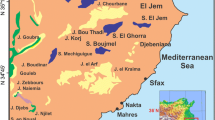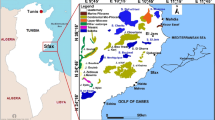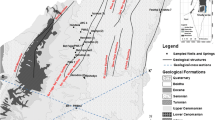Abstract
Stable isotopes of water and 14C activities (percent modern carbon, pmc) were used to estimate the timing of recharge and paleoclimatic conditions during recharge for three sandstone aquifers in Libya. These aquifers are part of the Nubian Aquifer System, with current and planned groundwater development designed to produce 106 m3/day of water. 14C activities from water samples collected at three wellfields (Sarir, Tazerbo and Al Kufra) indicate recharge during late Pleistocene and early Holocene. Stable isotope compositions from all three locations are significantly depleted relative to modern water, indicating that the climate was more humid than today. These results are in line with previous regional groundwater studies. This was the first study of its kind for the aquifers at Tazerbo and Sarir wellfield. The Tazerbo wellfield, which produces from the deepest aquifer, had the oldest estimated recharge ages (late Pleistocene). For Sarir, 14C activities ranged from 6.30 to 41.42 pmc; the Sarir aquifer is leaky confined and this range is likely due to mixing of shallow younger water with older deeper water. At Al Kufra, the 14C activity (5.27 pmc) of a well which is part of an agriculture project, is greater than the activity of wells sampled in 1973 (0.5–2.0 pmc). The greater activity is likely due to the lowering of the regional potentiometric surface causing younger water to be captured after four decades of wellfield operation. It is recommended that periodic monitoring be done in large wellfields to identify changes in isotope compositions as production continues.
Resume
Les isotopes stables de l’eau et l’activité du 14C (pourcentage du carbone moderne, pmc) ont été utilisés pour estimer la période de la recharge et les conditions paléoclimatiques pendant la recharge concernant trois aquifères gréseux en Libye. Ces aquifères appartiennent au système aquifère nubien avec une exploitation actuelle et à venir des eaux souterraines conçue pour produire 106 m3/jour d’eau. L’activité du 14C des échantillons d’eau collectés au niveau de trois champs captants (Sarir, Tazerbo et Al. Kufra) indiquent que la recharge a pris place au cours de la fin du Pléistocène et au début de l’Holocène. Les compositions en isotope stable des trois sites sont significativement appauvries par rapport aux eaux modernes, indiquant que le climat était plus humide qu’aujourd’hui. Ces résultats sont cohérents avec des études hydrogéologiques régionales antérieures. C’était la première étude de ce type pour les aquifères sur les champs captants de Tazerbo et de Sarir. Le champ captant de Tazerbo, qui produit à partir de l’aquifère le plus profond, est caractérisé par des âges estimés les plus anciens pour la recharge (fin Pléistocène). Pour Sarir, l’activité du 14C est comprise entre 6.3 et 41.42 pmc; l’aquifère de Sarir est captif avec des pertes et cette gamme de pmc est probablement due à un mélange d’eau plus jeune de faible profondeur avec une eau plus ancienne plus profonde. Au niveau du site d’Al Kufra, l’activité du 14C (5.27 pmc) d’un forage qui fait partie d’un projet agricole est plus grande que l’activité des forages échantillonnés en 1973 (0.5–2.0 pmc). L’activité plus grande est probablement due à un abaissement de la charge hydraulique au niveau régionale causant un captage d’une eau plus jeune après 4 décennies d’exploitation au niveau du champ captant. Il est recommandé de mener un suivi périodique au niveau des grands champs captants afin d’identifier des modifications dans les compositions isotopiques vu que l’exploitation se poursuit.
Resumen
Se utilizan las actividades de isótopos estable y de 14C (porcentaje de carbono moderno, pmc) fueron usados para estimar el tiempo de recarga y las condiciones paleoclimáticas durante la recarga para tres acuíferos de areniscas en Libia. Estos acuíferos son parte del Sistema acuífero de Nubia, con el desarrollo de agua subterránea actual y planificado diseñado para producir 106 m3/día de agua. Las actividades de 14C a partir de las muestras de agua recolectadas en los tres campos de pozos (Sarir, Tazerbo y Al Kufra) indican recarga durante el Pleistoceno tardío y el Holoceno temprano. Las composiciones de los isótopos estables de todas estas tres localizaciones están significativamente empobrecidas en relación con el agua moderna, lo cual indica que el clima fue más húmedo que en la actualidad. Estos resultados están en línea con los estudios regionales previos de agua subterránea. Este fue el primer estudio de esta clase para los acuíferos en los campos de pozos de Tazerbo y Sarir. El campo de pozos de Tazerbo, que produce a partir del acuífero más profundo, tuvo las edades estimadas más antiguas (Pleistoceno tardío). Para Sarir, las actividades de 14C van desde 6.30 a 41.42 pmc; en Sarir es un acuífero confinado filtrante y este rango es altamente probable que se deba a la mezcla de agua somera más joven con agua más vieja profunda. En Al Kufra, la actividad de 14C (5.27 pmc) de un pozo que es parte de un proyecto agrícola es mayor que la actividad de pozos muestreados en 1973 (0.5–2.0 pmc). La mayor actividad es altamente probable que se deba a la reducción de la superficie potenciométrica regional que provoca que agua más joven haya sido capturada después de cuatro décadas de operación del campo de pozos. Se recomienda realizar un monitoreo periódico en grandes campos de bombeo para identificar los cambios en la composición de isótopos a medida que la producción continúa.
摘要
利用水中稳定同位素及14C活性(现代碳百分比,pmc)估算利比亚三个砂岩含水层补给期间的补给时间选择及古气候条件。这些含水层是Nubian含水层系统的一部分,目前及规划的地下水开发量设定为106 m3/天。三个井场((Sarir、 Tazerbo 及 Al Kufra井场)采集的水样中的14C活性表明晚更新世和早全新世期间发生过补给。所有三个地方的稳定同位素组分相对于现代水来说消耗很大,表明当时的气候比现在更加湿润。这些结果与先前的区域地下水研究结果一致。对于Tazerbo和Sarir井场的含水层来说是第一次开展此类研究。Tazerbo井场从深层含水层中开采,估算的补给年代最老(晚更新世),而Sarir井场的地下水中,14C活性范围为6.30—41.42;Sarir含水层为渗漏性承压含水层,这个范围很可能是由于浅层较年轻的地下水与较老的深层地下水混合造成的。Al Kufra井场一口井中,14C活性((5.27 pmc)比973年井中水样的活性(0.5–2.0 pmc)大,这个井是农业项目的一部分。较大的活性可能是由于区域压力水面降低造成的,井场经过40年的运行,压力水面降低使较年轻的水被捕获。因此,建议大的井场在运行中要进行定期监测,以确定同位素组分的变化。
Resumo
Isótopos estáveis da água e atividades de 14C (percentagem de carbono moderno, pcm) foram usados para estimar o tempo de recarga e as condições paleoclimáticas durante a recarga para três aquíferos em arenitos na Líbia. Estes aquíferos são parte do Sistema Aquífero Núbio, com desenvolvimento atual e previsto de produção de 106 m3/dia de água. As atividades de 14C das amostras de água recolhidas em três campos de captação (Sarir, Tazerbo e Al Kufra) indicam recarga durante o Plistocénico tardio e o início do Holocénico. As composições de isótopos estáveis de todas as três localizações são significativamente reduzidas em relação à água moderna, indicando que o clima era mais húmido do que hoje. Estes resultados encontram-se em linha com estudos regionais prévios de águas subterrâneas. Este foi o primeiro estudo deste tipo para aquíferos nos campos de captações de Tazerbo e Sarir. O campo de captações de Tazerbo, que produz a partir do aquífero mais profundo, tem as idades estimadas de recarga mais antigas (Plistocénico tardio). Para Sarir, as atividades de 14C variaram de 6.30 a 41.42 pcm; o aquífero Sarir é semi-confinado, e esta gama é largamente devida à mistura de água subterrânea jovem de pouca profundidade com água antiga mais profunda. Em Al Kufra, a atividade de 14C (5.27 pcm) num poço que é parte de um projeto agrícola é maior que a atividade em poços amostrados em 1973 (0.5–2.0 pcm). A maior atividade é provavelmente devida ao rebaixamento da superfície potenciométrica regional, o que provoca a captação de água jovem após quatro décadas de operações nos campos de captação. É recomendada a monitorização periódica em grandes campos de captação, a fim de identificar as alterações nas composições isotópicas à medida que a produção continua.






Similar content being viewed by others
References
Ahmad MU (1983) A quantitative model to predict safe yield for wellfield in the Kufra and Sarir Basins, Libya. Ground Water J 21:58–66
Al Faitouri M (2013) Isotope and noble gas study of three aquifers in central and eastern Libya. PhD Thesis, Colorado State University, USA, 117 pp
Ball J (1927) Problems of the Libyan Desert. Geogr J 70(1):21–38
Edmunds WM (2005) Groundwater as an archive of climatic and environmental change. In: Aggarwal PK, Gat J, Froelich K (eds) Isotopes in the water cycle: past, present and future of a developing science. Springer, Berlin, pp 341–352
Edmunds WM (2009) Palaeoclimate and groundwater evolution in Africa: implications for adaptation and management. Hydrol Sci 54(4):781–792
Edmunds W, Wright E (1979) Groundwater recharge and palaeoclimate in the Sirte and Kufra basins, Libya. J Hydrol 40(3–4):215–241
Ezzat A (1959) Ecological studies of bottom living Amphipods in the Nozha Hydrodrome. Alexandria Institute of Hydrobiology, Notes and Memoirs, Extension Dept., Editing and Publication Section, Cairo, 16 pp
Fisk EP, Duffy CJ, Clyde CG, Jeppsen RW, DeGroot PH, Bhasker R, Liu W-K (1983) Hydrologic evaluation of the Coastal Belt Water Project Sarir and Tazerbo well fields, Libya. Paper 487, Utah Water Research Laboratory, Utah State University, Logan, UT, 128 pp
Gabert G, Kleinsorge H, Kreysing K, Venzlaff H (1961) Some results of ground water investigations in the republic of Sudan. In: Symposium of Athens. IASH Publ. no. 56, IASH, Wallingford, UK, pp 201–213
Ghoneim E, Benedetti M, El-Baz F (2012) An integrated remote sensing and GIS analysis of the Kufrah Paleoriver, eastern Sahara. Geomorphology 139:242–257
Gossel W, Ebraheem AM, Wycisk P (2004) A very large scale GIS-based groundwater flow model for the Nubian sandstone aquifer in Eastern Sahara (Egypt, northern Sudan and eastern Libya). Hydrogeol J 12:698–713
Heinl M, Brinkmann PJ (1989) A ground water model for the Nubian Aquifer System. IAHS Hydrol Sci J 34(4):425–447
Hoelzmann P, Kruse H-J, Rottinger F (2000) Precipitation estimates for the eastern Sahara paleomonsoon based on a water balance model of the West Nubian Paleolake Basin. Glob Planet Chang 26:105–120
Kuwairi A (2006) Water mining: the great man-made river, Libya. Proc Instit Civ Eng 159:39–43
Lloyd JW (1990) Groundwater resources development in the eastern Sahara. J Hydrol 119(1):71–87
Pachur H (1980) Climatic history in the late Quaternary in southern Libya and the western Libyan desert. In: Salem MJ, Busrewil MT (eds) The geology of Libya, vol 3. Academic, New York, pp 781–788
Pachur HJ (1996) Reconstruction of paleodrainage systems in Sirt Basin and the area surrounding the Tibesti Mountains: implications for the hydrological history of the region. In: Salem MJ, Mouzughi AJ, Hammuda OS (eds) The geology of Sirt Basin, vol 1. Elsevier, New York, pp 157–166
Pachur H, Hoelzmann P (2000) Late Quaternary palaeoecology and palaeoclimates of the eastern Sahara. J Afr Earth Sci 30(4):929–939
Pallas P (1981) Water resources of the socialist People’s Libyan Arab Jamahiriya. In: Salem MJ, Busrewil MT (eds) Geology of Libya. Academic, London, pp 539–594
Pallas P, Salem O (2000) Water resources utilization and management of the Socialist Peoples Arab Jamahiriya. In: Regional management of aquifer systems in arid zones: managing non-renewable resources. Proceedings of Tripoli Conference 1999, UNESCO, Paris, pp 147–172
Paillou P, Schuster M, Tooth S, Farr T, Rosenqvist A, Lopez S, Malezieux J-M (2009) Mapping of a major paleodrainage system in eastern Libya using orbital imaging radar: The Kufrah River. Earth Planet Sci Lett 277:327–333
Pim R, Binsariti A (1994) The Libyan great man-made river project, paper 2: the water resource. Proc ICE-Water Marit Energy 106(2):123–145
Ramos E, Mariano M, de Gibert JM, Tawengi K, Khoja A, Néstor D (2006) Stratigraphy and sedimentology of the Middle Ordovician Haouaz Formation (Murzuq Basin, Libya). AAPG Bull 90(9):1309–1336
Robinson C, El-Baz F, Al-Saud T, Jeon S (2006) Use of radar data to delineate palaeodrainage leading to the Kufra Oasis in the Eastern Sahara. J Afr Earth Sci 44:229–240
Roohi M (1996) A geological view of source-reservoir relationships in the western Sirt Basin. In: Salem MJ, El-Hawat AS, Sbeta AM (eds) Geology of the Sirt Basin, vol 1. Elsevier, Amsterdam, pp 323–336
Rusk DC (2001) Libya: petroleum potential of the underexplored basin centers—a twenty-first-century challenge. In: Downey MW, Threet JC, Morgan WA (eds) Petroleum provinces of the twenty-first century. AAPG Mem 74, AAPG, Tulsa, OK, pp 429–452
Sandford K (1935) Geological observations on the northwest frontiers of the Anglo-Egyptian Sudan and the adjoining part of the southern Libyan desert. Q J Geol Soc 91(1–4):323–381
Swailem FM, Hamza MS, Aly AIM (1983) Isotopic composition of groundwater in Kufra, Libya. Water Resour Dev 1(4):331–341
Voss CI, Soliman SM (2014) The transboundary non-renewable Nubian Aquifer System of Chad, Egypt, Libya and Sudan: classical groundwater questions and parsimonious hydrogeologic analysis and modeling. Hydrogeol J 22:441–468
Wright E, Benfield A, Edmunds W, Kitching R (1982) Hydrogeology of the Kufra and Sirte Basins, eastern Libya. Q J Eng Geol Hydrogeol 15(2):83–103
Acknowledgements
This research was in part funded by the Great Man-Made River Authority, Libya, with the support of Mr. Fawzi Saied. The authors thank W. Mike Edmunds for his thoughtful, constructive and in-depth review. Alan M. MacDonald and an anonymous reviewer are also thanked for their helpful comments.
Author information
Authors and Affiliations
Corresponding author
Rights and permissions
About this article
Cite this article
Al Faitouri, M., Sanford, W.E. Stable and radio-isotope analysis to determine recharge timing and paleoclimate of sandstone aquifers in central and southeast Libya. Hydrogeol J 23, 707–717 (2015). https://doi.org/10.1007/s10040-015-1232-7
Received:
Accepted:
Published:
Issue Date:
DOI: https://doi.org/10.1007/s10040-015-1232-7




